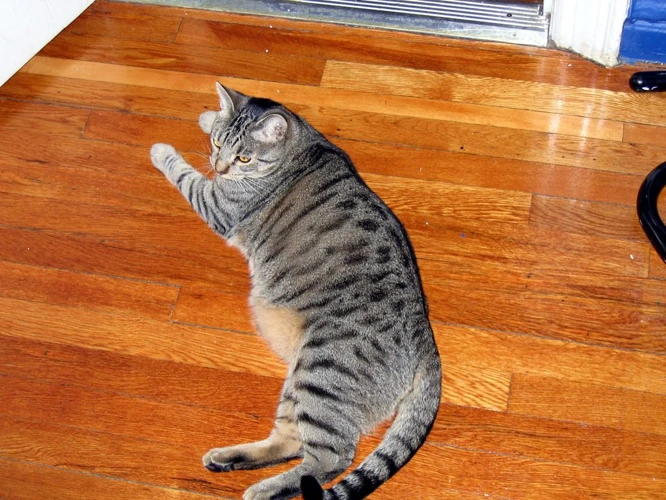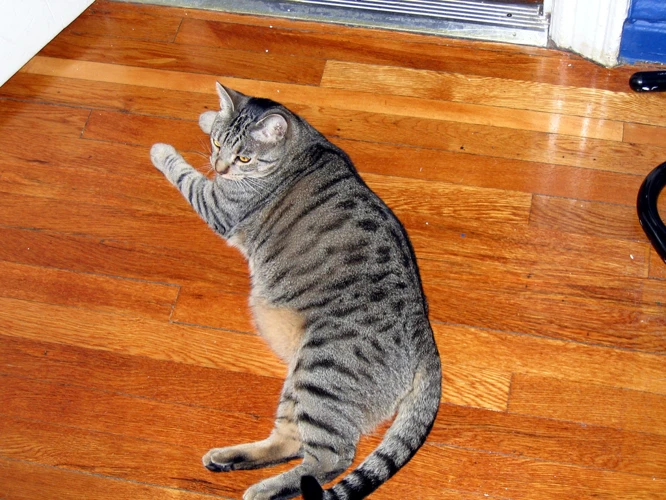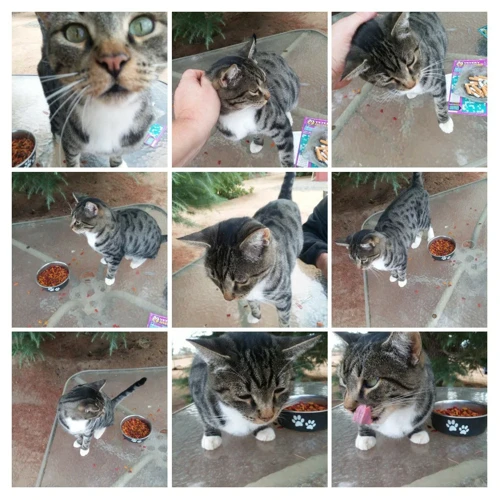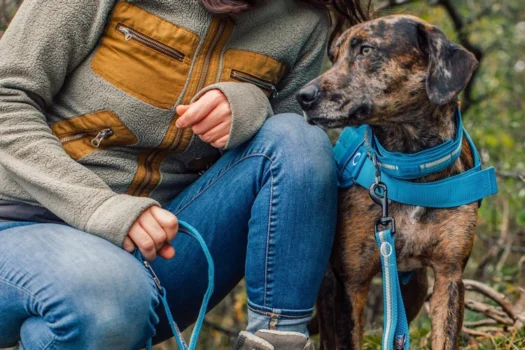Introduction to Advanced Leash Training for California Spangled Cats

When it comes to taking your California Spangled cat for a walk, leash training is an essential skill. Not only does it increase your cat’s safety, but it also provides them with an opportunity for exercise and exploration. Leash training can be a challenging process, but with a bit of patience and commitment, you can teach your cat to walk on a leash comfortably.
Before you dive into advanced leash training techniques, start with the basics. It’s recommended that you start leash training your California Spangled kitten from an early age, as they are more receptive to training when they are young. You may want to start by letting your kitten explore the leash on their own, allowing them to wear it around the house for short periods each day. This helps your kitten get used to wearing the leash before you introduce them to walking with it.
Once your kitten is comfortable with their leash, you can start teaching them to walk on it. Remember that patience is key during this process, so move at a pace that your cat is comfortable with. Positive reinforcement techniques, such as treats and affection, can be extremely effective during the training process.
As you progress with your cat’s leash training, you may encounter certain challenges, such as your cat pulling on the leash or getting easily distracted on walks. This is where advanced leash training techniques come in. By using these techniques, you can teach your California Spangled cat to walk calmly by your side and ignore distractions.
However, it’s essential to understand that there are common mistakes that you should avoid during advanced leash training. For example, punishing your cat during training sessions can be detrimental to their progress. Similarly, using the wrong type of leash or improper leash handling techniques can also make training more challenging.
In the following sections, we will explore the benefits of leash training your California Spangled cat, expert tips for advanced leash training, as well as common mistakes to avoid. With the right approach, patience, and commitment, you can master advanced leash training techniques and enjoy the benefits of exploring the great outdoors with your feline friend.
Why is Leash Training Important for California Spangled Cats?

Leash training for California Spangled cats is an important aspect of their overall health and wellbeing. Although cats are usually indoor animals, they still need proper exercise to keep them healthy and happy, which is where leash training becomes essential. There are several reasons why leash training is essential for these unique cats.
Increased safety
Firstly, leash training helps to keep California Spangled cats safe while exploring their environment. By keeping them on a leash, you can prevent them from running away, getting lost or being hit by a car. This especially important for cats that live in urban areas where there is vehicular traffic or other hazards.
Exploration and exercise
Secondly, leash training provides opportunities for the cat to explore and exercise. Unlike dogs which need more exercises, cats get their daily exercise through running around the house or apartment. However, by taking your trained California Spangled cat outside on its leash, he/she can expand his/her horizons, explore new surroundings and get plenty of exercise which will help ensure their muscles and joints remain healthy.
Leash training is an essential part of caring for California Spangled cats. It not only keeps them safe, but also provides opportunities for them to explore the world around them and get the necessary exercise. If you want to learn more about the benefits of leash training for California Spangled cats, you can check out this article.
Increased safety
One of the top priorities for any California Spangled cat owner is ensuring their cat’s safety. To further ensure their safety, leash training can be a crucial factor. By using a leash, you can keep your cat from running off and into dangerous situations, like oncoming traffic or other hazardous areas. The leash acts as a tool to keep your cat close by your side, preventing them from wandering off into harm’s way. Additionally, if your cat becomes spooked or frightened, the leash can help you maintain control and prevent them from escaping. It is essential to use the appropriate leash for your California Spangled cat and properly train them to wear it. You can learn more about selecting the right leash for your feline by checking out our guide on Cali Spangled cat leashes.
Exploration and exercise
Exploration and exercise
Leash training provides an opportunity for your California Spangled to explore the world outside while getting the much-needed exercise they require. By taking your cat outside, you are introducing them to new sights, sounds, and smells that they wouldn’t experience indoors. It helps in preventing boredom, which can lead to destructive behavior in cats.
When starting out with leash training, it’s essential to begin slowly. Start by allowing your cat to become familiar with the collar and leash inside the home before venturing outside. Choose a quiet and calm area away from traffic and other distractions. Once your cat becomes comfortable wearing the leash and collar, you can gradually increase the distance and duration of the walks.
During each walk, allow your cat to explore and sniff around as this will help maintain their interest. Also, try incorporating fun activities into your walks to keep your cat engaged, such as bringing along toys or treats. Not only will this make the walks more exciting, but it’s also an excellent way to reinforce positive behavior.
Remember to monitor your California Spangled’s behavior closely during walks, especially if they are new to leash training. Be sure to watch for any signs of distress or discomfort, and do not force them to continue walking if they seem scared or anxious.
Leash training your California Spangled can be a fantastic way to help them stay active and stimulate their senses. With patience and consistency, you can teach your cat to enjoy and benefit from outdoor walks. For more information on common mistakes to avoid during advanced leash training, be sure to check out our article on mistakes to avoid. If you’re just starting with leash training your California Spangled, you may want to check our article on starting leash training with your kitten. And if you’re looking for tips on choosing the right leash for your California Spangled, check out our article on Cali Spangled Leash.
Expert Tips for Advanced Leash Training of Your California Spangled Cat

Leash training your California Spangled cat can be a challenging but rewarding experience for both you and your furry friend. With expert tips and a bit of patience, you can train your cat to walk on a leash and explore the outside world while enjoying the safety and security of being by your side.
Teaching your cat to walk on a leash: While some cats take to leash walking naturally, others may require a bit of training before feeling comfortable outside. Start by introducing your cat to the harness and leash inside your home, allowing them to sniff and become familiar with these new accessories. Once your cat is comfortable wearing the harness, attach the leash and let them lead you around your home. Gradually increase the length of the leash and encourage your cat to follow you.
Positive reinforcement techniques: Use positive reinforcement to encourage your cat to continue leash walking. Treats, praise, and affection can be effective rewards for good behavior. Offer treats when your cat follows you or walks calmly by your side. If your cat becomes scared or overstimulated, give them a break and try again later.
Training your cat to stop pulling on the leash: Some cats may pull on the leash, which can be frustrating for owners. To teach your cat not to pull, stop walking when you feel tension on the leash. Wait for your cat to relax and then continue walking. Repeat this process until your cat learns not to pull on the leash.
Teaching your cat to ‘heel’ on a leash: Once your cat has mastered basic leash walking, you can teach them to heel. When your cat has relaxed on the leash, use a simple command, such as “heel,” while walking. Gradually decrease the distance between you and your cat, until they are walking directly by your side.
Remember, the training process takes time and patience, and every cat learns at their own pace. Keep training sessions short and positive, and always end a session on a high note. With consistent training and a bit of dedication, you can enjoy long walks with your California Spangled cat by your side.
Teaching your cat to walk on a leash
Are you a California Spangled cat owner looking to take your feline friend on a walk outside to enjoy the sunshine and fresh air? Leash training your cat is a great way to allow them to enjoy the outdoors safely while also promoting physical activity. However, teaching your cat to walk on a leash can be a difficult task. The first step is introducing your cat to the leash and collar. Make sure to use a comfortable harness that fits properly to avoid discomfort for your cat. Once your cat is comfortable with the harness, it’s time to start leash training. Keep in mind, this process may take some time and patience but will be rewarding in the end. Let’s explore some helpful techniques for leash training your California Spangled cat.
Positive reinforcement techniques
Using positive reinforcement techniques is a crucial part of advanced leash training for your California Spangled cat. Here are some effective techniques that can help you train your feline friend in a positive manner:
- Clicker training: Clicker training involves using a small device that makes a clicking sound when pressed. You can use it to mark desirable behavior in your cat during leash training and immediately reward them with treats or praise. The sound of the clicker serves as a signal to your cat that they have made progress towards learning their leash manners.
- Treats: Treats are an effective way to reward your cat for good behavior during leash training. Use small, bite-sized treats that your cat loves and give them immediately after they perform a desirable behavior, such as walking calmly on the leash or ignoring a distraction. This positive reinforcement will encourage them to repeat the behavior in the future.
- Praise and affection: Don’t underestimate the power of verbal praise and physical affection. When your cat performs a desirable behavior, give them a pat on the head, scratch behind the ears, or use a soothing tone of voice to tell them they’re doing a good job. This will create a positive association with leash training, making it more enjoyable for your cat and increasing the likelihood that they’ll continue to behave in a positive manner on the leash.
Remember, consistency is key when using positive reinforcement techniques. Keep the treats handy, bring the clicker on every walk, and be sure to offer praise and affection every time your cat performs a desirable behavior. With practice, patience, and positive reinforcement, your California Spangled cat will soon become a pro at leash training.
Training your cat to stop pulling on the leash
Leash pulling is a common issue that cat owners experience while walking their cats. It can be frustrating, ineffective, and even dangerous for both the cat and the owner. It is important to teach your California Spangled how to walk on a leash without pulling. Here are some advanced training techniques to help you accomplish this goal.
1. Stop the movement when your cat pulls
When your cat starts to pull on the leash, the natural tendency might be to pull back. However, this approach will only worsen the problem. Instead, stop walking immediately and stand still until your cat stops pulling. Once your cat has stopped pulling, start walking again.
2. Use positive reinforcement
It is important to reward your California Spangled when they walk without pulling. Positive reinforcement can be anything from verbal praise to treats. When they succeed in staying close to you without pulling, give them a reward. This will encourage the behavior you want to see in your cat.
3. Use the right leash and collar combination
Using the right leash and collar combination is very important when training your cat to stop pulling. A properly fitted, sturdy collar and a lightweight leash are always recommended. Try using a harness, such as the figure-eight harness, which fits comfortably around the cat’s neck and torso. This will allow you to control your cat’s movements and prevent them from pulling.
4. Keep your cat engaged
One of the main reasons why cats pull on the leash is because they become bored or distracted. To keep your California Spangled engaged, incorporate fun activities during walks. Make sure that the walking route is filled with interesting sights, smells, and sounds. You can also engage your cat in play, take frequent breaks, or offer treats to keep them engaged.
5. Gradually increase the walking distance
It is important to increase the walking distance gradually as your cat gets comfortable with walking on a leash. Start with short distances and lengthen the walk over time. This will allow your cat to become more comfortable with the leash and the surrounding environment.
6. Be patient and consistent
Remember that leash training takes time and patience. Do not expect your cat to learn everything overnight. Consistent training and positive reinforcement will help your cat to develop the desired behavior. The more you practice, the better your cat will become at walking on a leash without pulling.
By incorporating these advanced training techniques, you can teach your California Spangled to walk on a leash without pulling. Remember to keep the training fun and positive, and always be patient and consistent.
Teaching your cat to ‘heel’ on a leash
One of the most important leash training techniques is teaching your California Spangled to ‘heel’ on a leash. This means that your cat walks calmly by your side instead of pulling or meandering around. This technique is not only important for safety but also helps establish a bond between you and your cat.
Step 1: Start Slow
Begin by walking your cat on a loose leash, letting them explore and meander as they please. Gradually start to slow down and stop when your cat pulls on the leash.
Step 2: Use Positive Reinforcement
When your cat walks calmly by your side, reward them with positive reinforcement techniques like treats or praise. This will encourage them to continue walking in this manner.
Step 3: Use Verbal Commands
Use verbal cues like “heel” or “walk with me” consistently while training your cat to walk by your side. This will help them associate the command with the desired behavior.
Step 4: Keep Leash Loose
Make sure that the leash is always loose and not taut. This will help your cat understand that they are not being restrained but are rather walking alongside you.
Step 5: Stay Patient
Remember that leash training takes time and patience. Some cats may take longer to learn than others, so don’t get discouraged if progress is slow.
By following these steps and being consistent with training, you can teach your California Spangled to ‘heel’ on a leash. This technique will enhance the bond between you and your cat, and make walks a more enjoyable and safer experience for both of you.
Advanced Training Techniques to Improve Your California Spangled’s Behavior on a Leash

Training your California Spangled to walk politely on a leash requires consistent effort and patience. Once your cat has mastered the basics of walking on a leash, it’s time to move on to more advanced training techniques that will help improve their behavior and responsiveness while on a walk.
Training your cat to ignore other animals and distractions on a walk: California Spangled cats are highly curious and easily distracted, which can make leash training a challenge. Advanced training techniques involve teaching your cat to ignore other animals and distractions while on a walk. One technique that can be effective is counter-conditioning. This involves gradually introducing your cat to new stimuli that might distract them, while simultaneously rewarding them for good behavior such as walking calmly by your side. If your cat starts to get distracted, give them a verbal cue, such as “leave it,” and reward them with a treat when they successfully ignore the distraction.
Training your cat to walk calmly by your side in any environment: Once your cat is comfortable walking on a leash in a familiar environment, it’s important to slowly introduce them to different environments and challenges. This will help ensure that they remain calm and well-behaved no matter where you take them. Practice walking your California Spangled in different environments such as crowded streets, parks, and even near other animals. Reward your cat for good behavior and use positive reinforcement techniques to encourage them to walk calmly by your side.
Training your cat to come when called: Recall training is an essential part of leash training any cat, but it becomes even more important when dealing with an intelligent and curious cat like the California Spangled. Use a specific command word such as “come” or “here” and reward your cat when they come to you. Start by practicing in a quiet and controlled environment, gradually increasing the distance between you and your cat. Once your cat has mastered recall in a familiar environment, start practicing in different locations.
Remember, it’s important to always reward good behavior with treats, praise, or playtime. Never punish your California Spangled during leash training, as this can damage your cat’s trust and obedience. With patience and positive reinforcement, you can teach your cat to become a well-behaved and obedient walking companion.
Training your cat to ignore other animals and distractions on a walk
As much as we love taking our California Spangled cats out for a walk, it can be a challenge when there are other animals and distractions around. It is natural for your feline friend to get excited and chase after other animals, birds, or even insects. However, it is important to train your cat to keep their focus on you during the walk. This can ensure both your and your cat’s safety as well as make the walk more enjoyable. Let’s explore some techniques to help your cat ignore other animals and distractions on a walk.
Training your cat to walk calmly by your side in any environment
The ability to walk calmly by your side in any environment is a critical skill that any California Spangled owner should teach to their furry friend. Here are some techniques to achieve this:
1. Start with Basic Leash Training: Before your cat can walk calmly by your side in any environment, they need to be comfortable walking on a leash in general. Start with walking them in a quiet, familiar area and gradually increasing the duration of the walks. Keep the leash loose and avoid pulling on it.
2. Practice in Different Environments: Once your cat is comfortable walking on a leash, gradually introduce them to different environments. Start with quiet areas with minimal distractions and gradually move to busier areas. Reward your cat with treats and praise for staying calm.
3. Teach “Heel” Command: Teach your cat to walk beside you by rewarding them with treats when they are in the correct position. Use a “heel” command and stop if they move too far ahead or behind. Practice this in a quiet area and gradually introduce distractions.
4. Use Positive Reinforcement: Positive reinforcement is key to teaching your cat to walk calmly by your side in any environment. Reward them with treats and praise for good behavior and avoid punishing or scolding them for mistakes.
5. Be Patient: Remember that every cat is unique, and some may take longer to learn than others. Be patient and consistent with your training, and your California Spangled will eventually learn to walk calmly by your side in any environment.
By following these techniques, you can teach your California Spangled to walk calmly by your side in any environment and enjoy the benefits of exploring the outdoors together.
Training your cat to come when called
Training your cat to come when called is an important skill that can help keep your California Spangled safe. Here are some expert tips and techniques to help you teach your cat to come when called.
| Tip | Explanation |
|---|---|
| Use a distinctive call | Use a unique, positive sound to encourage your cat to come to you. Avoid using negative tones or scolding. |
| Use treats and positive reinforcement | Reward your cat with treats and praise when they come to you. Use a special treat that your cat only receives during training sessions. |
| Start slow and gradually increase distance and distractions | Start with short distances and minimal distractions. As your cat gets better, gradually increase distance and add more distractions to the environment. |
| Don’t chase your cat | Avoid chasing your cat if they don’t come to you. This can turn the training session into a game and make it challenging to train your cat to come when called. |
| Be patient and consistent | Training your cat to come when called takes time and patience. Stay consistent with your training sessions and don’t get discouraged if your cat doesn’t come right away. |
Remember, coming when called is a skill that will take time and practice to perfect. By using positive reinforcement and patience, you can teach your California Spangled to come when called and enjoy safe outdoor adventures together.
Common Mistakes to Avoid during Advanced Leash Training
When it comes to leash training your California Spangled, there are several common mistakes to avoid. These mistakes can hinder your progress and make the training process more difficult than it needs to be. Here are some tips to help you avoid these common mistakes:
Avoid punishing your cat during training
One of the biggest mistakes you can make during leash training is punishing your cat for mistakes. Cats respond much better to positive reinforcements, so punishing them for not behaving the way you want them to could cause more harm than good. Instead, use positive reinforcements like treats and praise to encourage good behavior.
Don’t skip training sessions
Consistency is key when it comes to training your California Spangled. Skipping training sessions could undermine all of the progress you’ve made thus far. While it may be tempting to take a break from training when you’re feeling frustrated or overwhelmed, it’s important to stay committed and stick to your training routine.
Use the proper leash and handling techniques
Using the wrong leash or handling techniques is another common mistake during leash training. Make sure you choose a leash that fits your cat comfortably and provides enough length for them to explore. Also, be sure to use the proper handling techniques, like holding the leash at a comfortable length and keeping your cat close to your side.
By avoiding these common mistakes, you can make your California Spangled’s leash training experience more positive and successful. Remember, patience, consistency, and positive reinforcement are key when it comes to training your furry friend.
Punishing your cat during training
One of the biggest mistakes cat owners can make during leash training is to punish their feline friend when they make a mistake. While it may be tempting to yell or use physical force to correct unwanted behavior, it can actually do more harm than good. Cats are sensitive creatures and respond much better to positive reinforcement techniques. Punishing your California Spangled during training can create fear and anxiety, resulting in a cat that is even harder to work with on a leash. Instead, focus on building a strong and positive bond with your cat through patience and encouragement.
Skipping training sessions
Skipping Training Sessions: The Consequences for Your California Spangled
Skipping training sessions can have serious consequences for the success of your California Spangled’s leash training. Consistency is key when it comes to training your cat to walk on a leash and ignoring training sessions can have a negative impact on progress.
Here are some consequences of skipping training sessions:
| Consequence | Description |
| Regression | If you skip training sessions, your California Spangled may forget the commands they’ve learned and may revert back to their old behavior, making it harder to continue training. |
| Confusion | Inconsistent training can lead to confusion for your cat. If they only receive training sporadically, they may not be able to fully understand what is expected of them on the leash. |
| Missed Opportunities | If you don’t train your California Spangled on a regular basis, you may miss out on opportunities to observe and correct any issues with their behavior on the leash. |
| Frustration | Skipping training sessions can lead to frustration for both you and your cat. Your California Spangled may become bored or agitated, making future training sessions more difficult. |
Skipping training sessions can significantly setback or even undo the training progress made with your California Spangled. Make sure to set aside consistent time for training and stick to a schedule to avoid any setbacks.
Using the wrong leash or inappropriate leash handling techniques
When it comes to leash training your California Spangled cat, it’s important to use the right leash and handle it appropriately. Using the wrong leash or handling technique could be uncomfortable or even harmful for your cat. To avoid any risks, here are a few things to keep in mind:
| Wrong leash type | Consequence |
|---|---|
| A retractable leash | This type of leash gives your cat too much freedom and could cause them to run too far ahead, potentially into danger. It also doesn’t give you as much control over your cat’s movements. |
| A heavy chain leash | This type of leash is too heavy and can put unnecessary strain on your cat’s neck. It’s also less comfortable for your cat to wear, which could make them less likely to want to be on a leash. |
| A long, thin leash made of weak material | This type of leash can easily break if your cat pulls too hard, which could put them in danger if they run into traffic or other hazards. |
In addition to using the right type of leash, it’s important to use appropriate handling techniques. Some things to avoid include:
- Don’t jerk the leash. This can be painful for your cat and could cause them to lose trust in you or become fearful of walks.
- Don’t yank your cat by the leash. This is also painful and could lead to injury or discomfort for your cat.
- Don’t drag your cat by the leash. This is uncomfortable for your cat and doesn’t teach them anything about proper leash etiquette.
Instead, use a gentle touch when handling the leash. Lead your cat with purpose, but avoid any sudden movements or jerks. Remember to stay patient and consistent with your training, and always prioritize your cat’s safety and comfort. With the right leash and handling techniques, you can help your California Spangled cat become a confident and obedient walker.
Conclusion: Mastering Advanced Leash Training Techniques for Your California Spangled
After reading through the expert tips and advanced leash training techniques for your California Spangled, it’s clear that mastering leash training is an important aspect of caring for your pet. By providing your cat with the opportunity to explore the outdoors safely while receiving exercise, you’re also providing them with mental stimulation and room for growth.
However, it’s important to remember that advanced leash training is a gradual process that requires patience and consistency. Rushing the training or punishing your cat during training sessions will only lead to setbacks and negative associations with leash training. Instead, use positive reinforcement techniques and gradually increase the difficulty of the training.
Another key aspect of successful leash training is using the right leash and leash handling techniques. It’s important to choose the appropriate length and material of the leash, as well as to always hold the leash securely and monitor your cat’s behavior closely. This will help prevent your cat from jumping, pulling, or getting tangled in the leash.
Lastly, remember that advanced leash training is not a one-and-done process. It’s important to continue practicing and reinforcing the training throughout your pet’s lifetime. By doing so, you’ll be able to fully enjoy the benefits of a well-trained California Spangled on a leash.
By following these expert tips and techniques, taking the time to properly train your cat, and consistently reinforcing the training, you can master advanced leash training techniques for your California Spangled. This will not only improve your cat’s behavior on a leash, but also enhance the bond between you and your feline friend.
Frequently Asked Questions
How long does it take to train a California Spangled cat to walk on a leash?
It can take several weeks or even months of consistent training to teach your California Spangled cat to walk on a leash. The amount of time required will depend on the individual cat’s temperament and previous experience with leash training.
What type of leash is best for leash training a California Spangled cat?
A lightweight, flexible leash made of nylon or leather is best for leash training a California Spangled cat. Avoid using retractable leashes, as they can be difficult to control and may encourage pulling.
Can all California Spangled cats be trained to walk on a leash?
While most California Spangled cats can be trained to walk on a leash, some cats may not enjoy it or may not respond well to training. It’s important to respect your cat’s individual preferences and personality when it comes to leash training.
Is it safe to take a California Spangled cat on a walk outside?
As long as you take the proper precautions, it can be safe to take your California Spangled cat on a walk outside. Be sure to keep your cat on a leash at all times, avoid busy roads and other hazards, and monitor your cat’s behavior closely.
What are some signs that my California Spangled cat is not enjoying leash training?
If your California Spangled cat is afraid or stressed by leash training, they may exhibit signs of fear or anxiety such as trembling, cowering, or trying to escape. Be sure to watch your cat’s body language closely and stop training if they seem overwhelmed.
How can I make leash training more fun for my California Spangled cat?
Using positive reinforcement techniques such as treats and encouraging words can help make leash training more enjoyable for your California Spangled cat. You can also try walking in new and interesting locations to provide additional stimulation.
Can I train my California Spangled cat to walk off-leash?
It is generally not recommended to train a California Spangled cat to walk off-leash, as this can be dangerous and may result in your cat getting lost or injured. Always keep your cat on a leash when outside.
Should I punish my California Spangled cat if they pull on the leash?
No, punishing your California Spangled cat for pulling on the leash can be counterproductive and may make your cat fear or dislike leash training. Instead, focus on positive reinforcement techniques such as rewarding your cat for walking calmly on the leash.
What should I do if my California Spangled cat gets spooked while on a walk?
If your California Spangled cat gets scared or spooked while on a walk, it’s important to remain calm and avoid pulling on the leash. Try to reassure your cat with a soothing voice and provide a safe space for them to retreat to if necessary.
Can I walk my California Spangled cat in the rain?
Walking your California Spangled cat in the rain is possible, but it’s important to take precautions such as using a raincoat or umbrella to keep both you and your cat dry and comfortable. Be sure to monitor your cat’s behavior closely and avoid walking in heavy rain or thunderstorms.







